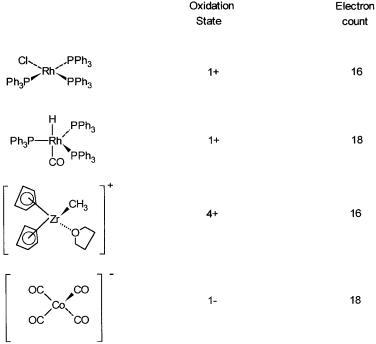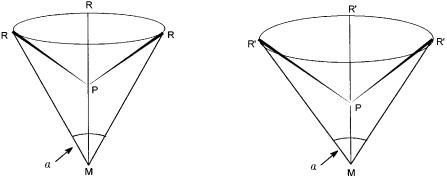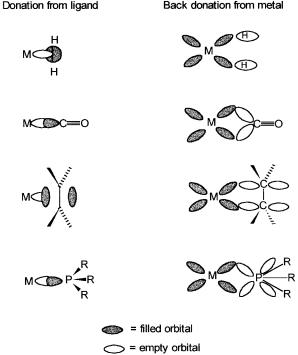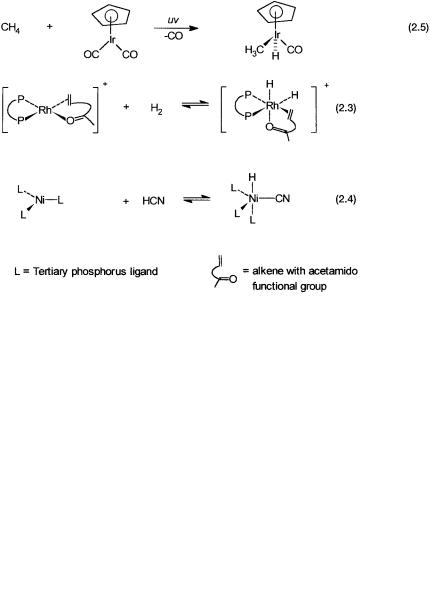
Homogeneous Catalysis
.pdf
Homogeneous Catalysis: Mechanisms and Industrial Applications
Sumit Bhaduri, Doble Mukesh
Copyright 2000 John Wiley & Sons, Inc.
ISBNs: 0-471-37221-8 (Hardback); 0-471-22038-8 (Electronic)
CHAPTER 2
BASIC CHEMICAL CONCEPTS
In this chapter we discuss some of the basic concepts of organometallic chemistry and reaction kinetics that are of special relevance to homogeneous catalysis. The catalytic activity of a metal complex is influenced by the characteristics of the central metal ions and the attached ligands. We first discuss the relevant properties of the metal ion and then the properties of a few typical ligands.
2.1THE METAL
Insofar as the catalytic potential of a metal complex is concerned, the formal charge on the metal atom and its ability to form a bond of optimum strength with the incoming substrate are obviously important. We first discuss a way of assessing the charge and the electronic environment around the metal ion. The latter is gauged by the “electron count” of the valence shell of the metal ion.
2.1.1Oxidation State and Electron Count
The formal charge assigned to a metal atom in a metal complex is its oxidation state. The sign of the charge for metal is usually positive, but not always. It is assigned and justified on the basis of relative electronegativities of the central metal atom and the surrounding ligands. The important point to note is that a fully ionic model is implicit, and to that extent the formal oxidation state may not correspond to the real situation. It does not take into account the contribution from covalency, that is, electrons being shared between the metal atom and the ligand, rather than being localized either on the ligand or on the metal.
13

14 BASIC CHEMICAL CONCEPTS
A few examples of special relevance to homogeneous catalytic systems are given in Fig. 2.1, along with total electron counts. The rationales behind the schemes that are used to arrive at the electron counts are described in the following.
Electron counting could be done either after assignment of an oxidation state to the metal (i.e., assuming ionic character in the bonds) or without assigning any oxidation state (i.e., assuming full covalency and zero oxidation state of the metal). In the latter case, the counting is very similar to the procedure of counting electrons in CH4, NH3, etc. to arrive at the octet rule. Both ways of counting electrons are illustrated.
RhCl(PPh3)3: The chlorine radical (Cl ) accepts an electron from rhodium metal (electronic configuration 4d 7,5s 2) to give Cl and Rh . The chloride ion then donates two electrons to the rhodium ion to form a dative or a coordinate bond. Each PPh3 donates a lone pair of electrons on the phosphorus atom to the rhodium ion. The total number of electrons around rhodium is therefore 82 3 2 = 16, and the oxidation state of rhodium is obviously 1 . The other way of counting is to take the nine electrons of rhodium and add one electron for the chlorine radical and six for the three neutral phosphine ligands. This also gives the same electron count of 16.
Figure 2.1 Formal oxidation states and valence electron counts of metal ions in some homogeneous catalysts.
THE METAL |
15 |
Similarly, for RhH(CO)(PPh3)3 the rhodium oxidation state is 1 because the hydrogen atom is assumed to carry, with some justification, a formal negative charge. The five ligands, H , CO, and three PPh3, each donate two electrons, and the electron count therefore is 8 5 2 = 18. With the covalent model the hydrogen ligand is treated as a radical, rhodium is considered to be in a zero oxidation state, and the electron count is 9 1 4 2 = 18.
[Cp2Zr(CH3)(THF)] : The zirconium oxidation state is 4 and each Cp ligand donates six electrons. The ligand CH3 donates two electrons. The solvent molecule, THF, also donates two electrons, and the total electron count is 12
0 2 2 = 16. With the covalent model zirconium is in the zero oxidation state and has four electrons (4d 2,5s 2) in the valence shell. Both Cp and CH3 are considered as radicals and therefore donate five and one electron, respectively. The valence electron count is therefore 4 2 5 1 2 1 = 16.
Notice that because of the positive charge, we subtract one electron. Co(CO)4 : Since there is a net negative charge and CO is a neutral ligand,
the formal oxidation state of cobalt is 1 . The electron count is therefore 10
4 2 = 18. According to the covalent model, the electron count is also 9
4 2 1 = 18, but cobalt is assumed to be in a zero oxidation state, and one electron is added for the negative charge.
It should be clear from the preceding examples that as long as we are consistent in our ways of counting electrons, either method will give the same the answer. Like the octet rule for the first-row elements, there is an 18-electron rule for the transition metals. The rationale behind this rule is simply that the metal ion can use nine orbitals—five d orbitals, three p orbitals, and one s orbital—for housing electrons in its valence shell. Methane, water, etc. are stable molecules, as they have eight electrons around the central atom. Similarly, organometallic complexes that have 18 electrons in the outer shell are stable complexes. This rule is often referred to as the “eighteen-electron rule” or the rule of effective atomic number (EAN).
2.1.2Coordinative Unsaturation
Complexes that have CO, PPh3, H etc. as ligands tend to be reactive if the electron count is less than eighteen. They undergo reactions to form extra bonds so that an electron count of 18 is reached. When the electron count is less than 18, the metal complex is often classified as coordinatively unsaturated. Among the complexes shown in Fig. 2.1, RhCl(PPh3)3 is coordinatively unsaturated, while RhH(CO)(PPh3)3 and Co(CO)4 are coordinatively saturated. Apart from RhCl(PPh3)3, there are many other reactive complexes with an electron count of 16.
High reactivity may also result from easy displacement of weakly bound ligands. The zirconium compound [Cp2Zr(THF)(CH3)] , shown in Fig. 2.1 and discussed in the previous section, is an example. Unlike RhCl(PPh3)3, which tries to form extra bonds in its reactions, the zirconium compound’s reactivity in a catalytic reaction is due to the easy displacement of THF by the substrate.

16 BASIC CHEMICAL CONCEPTS
The term coordinative unsaturation includes this type of reactivity also. In other words, the ability to form extra bonds or facile displacement of weakly bound ligands, which in many cases may just be solvent molecules, are both manifestations of coordinative unsaturation.
Coordinative unsaturation can sometimes be induced by using bulky ligands. A few such ligands can take up most of the space around the metal atom and prevent the presence of a full complement of ligands. So due to steric constraints, an 18-electron count, which only a full complement of ligands can give, is not achieved. As an example, nickel in the zero oxidation state requires the presence of four monodentate phosphorus ligands to give an electron count of 18. However, if these ligands are bulky, then steric repulsion between them causes ligand dissociation, and the following equilibrium is established. The species NiL3 on the right-hand side of the equilibrium has an electron count of 16 and is coordinatively unsaturated.
NiL4 ` NiL3 L |
(2.1) |
A quantitative estimation of the steric demand of L can be made in terms of its cone angle. As shown in Fig. 2.2, it is the angle of a cone with its vertex at the metal atom and a metal–phosphorus distance of about 22.8 nm. The cone is created by the surface that just encloses all the ligand atoms for all orientations resulting from the rotation around the metal–phosphorus bond.
Finally, many complexes that participate in homogeneous catalytic reactions have electron counts less than 16. This is especially true for high-oxidation- state early-transition-metal complexes such as (C2H5)TiCl3, Ti(OPri)4, etc. Catalytically active, late-transition-element complexes with electron counts less than sixteen are also known. An important example is RhCl(PPh3)2, a 14-elec- tron complex that plays a crucial role in homogeneous hydrogenation reactions (see Section 7.3.1).
Figure 2.2 Cone angles ( ) with two different phosphines PR and PR . In both the
3 3
M–P distance is 22.8 nm.
IMPORTANT PROPERTIES OF LIGANDS |
17 |
2.1.3Rare Earth Metals
The examples discussed so far are all transition metal complexes. As we will see later (Chapters 4–9), most homogeneous catalytic processes are indeed based on transition metal compounds. However, catalytic applications of rare earth complexes have also been reported, although so far there has not been any industrial application. Of special importance are the laboratory-scale uses of lanthanide complexes in alkene polymerization and stereospecific C–C bond formation reactions (see Sections 6.4.3 and 9.5.4).
The points to note are that, unlike transition-metal-based homogeneous catalysts where the metal ions can have a wide range of oxidation states, the rare earth ions in almost all cases are in the 3 oxidation state. Also, electron count has little significance for these complexes. There is a similarity between high- oxidation-state early-transition-metal complexes and those of rare earths. In both the cases ligand dissociation or some other similar mechanism generates coordinative unsaturation. In both cases the substrates are activated by direct interaction with small, highly electropositive metal ions. Finally, in both cases the oxidation states of the metal ions do not change during catalysis.
2.2IMPORTANT PROPERTIES OF LIGANDS
A very large number of different types of ligands can coordinate to transition metal ions. Once coordinated the reactivity of the ligands may dramatically change. Here we first discuss some of the ligands that are often involved in homogeneous catalytic reactions.
2.2.1CO, R2C CR2, PR3, and H as Ligands
The traditional definition of a coordinate or a dative bond is the donation and sharing of electrons, usually a lone pair, by the ligand onto and with the metal. In other words, all ligands behave as Lewis bases, and the metal ion acts as a Lewis acid. The ligands listed are no exception insofar as the electron donation part is concerned. Both CO and PPh3 donate lone pairs on the carbon and the phosphorus atoms, respectively. With alkenes, since there are no lone pairs, it is the electrons that are donated and shared. Similarly, a gain of one electron from the metal by the hydrogen atom produces a hydride ligand, which then donates and shares the electron pair with the metal ion.
The first three of these ligands, and there are a few others, such as N2, NO, etc., differ from H2O, NH3, etc. in that they also accept electron density from the metal; that is, they act as Lewis acids. The electron density is often accepted in an orbital of *, symmetry and in such cases the ligands are called acid ligands. The donation of electron density by the metal atom to the ligand is also referred to as back-donation. While H does not act as a Lewis acid, dihydrogen does. In fact, such an interaction is responsible for the formation

18 BASIC CHEMICAL CONCEPTS
of stable metal–dihydrogen complexes. In the extreme case where two electrons are formally transferred back to dihydrogen from the metal, the H–H bond breaks, and two H ligands are formed. For this reason we consider H along with acid ligands. Fig. 2.3 shows the Lewis acid–like behavior of CO, C2H4, and H2 in terms of overlaps between empty ligand and filled metal orbitals of compatible symmetry. Back-donation is a bonding interaction between the metal atom and the ligand because the signs of the donating metal d orbitals and the ligand * ( * for H2) acceptor orbitals match.
The ligands play important roles in a large number of homogeneous catalytic processes. Alkene polymerization and a variety of other reactions involve alkene coordination (see Chapters 6 and 7). As the name suggests, CO is the main ligand in carbonylation reactions (see Chapter 4). All four ligands: CO, alkene, H , and PR3, play important parts in hydroformylation reactions (see Chapter 5).
2.2.2Alkyl, Allyl, and Alkylidene Ligands
Alkyl complexes are intermediates in a number of homogeneous catalytic processes, such as carbonylation, alkene polymerization, hydrogenation, etc. Allyl
Figure 2.3 Schematic presentation of orbital overlaps for metal–ligand bond formations.
IMPORTANT REACTION TYPES |
19 |
ligands are important in catalytic hydrocyanation reactions, and a number of other reactions where butadiene is used as one of the starting materials (Chapter 7). Alkylidene intermediates are involved in alkene metathesis reactions. Representative examples of these three ligands are given in Fig. 2.4.
All these ligands have extensive chemistry; here we note only a few points that are of interest from the point of view of catalysis. The relatively easy formation of metal alkyls by two reactions—insertion of an alkene into a metal–hydrogen or an existing metal–carbon bond, and by addition of alkyl halides to unsaturated metal centers—are of special importance. The reactivity of metal alkyls, especially their kinetic instability towards conversion to metal hydrides and alkenes by the so-called -hydride elimination, plays a crucial role in catalytic alkene polymerization and isomerization reactions. These reactions are schematically shown in Fig. 2.5 and are discussed in greater detail in the next section.
Alkylidene complexes are of two types. The ones in which the metal is in a low oxidation state, like the chromium complex shown in Fig. 2.4, are often referred to as Fischer carbenes. The other type of alkylidene complexes has the metal ion in a high oxidation state. The tantalum complex is one such example. For both the types of alkylidene complexes direct experimental evidence of the presence of double bonds between the metal and the carbon atom comes from X-ray measurements. Alkylidene complexes are also formed by -hydride elimination. An interaction between the metal and the -hydrogen atom of the alkyl group that only weakens the C–H bond but does not break it completely is called an agostic interaction (see Fig. 2.5). An important reaction of alkylidene complexes with alkenes is the formation of a metallocycle.
Allyl ligands have features common to metal–alkyl and metal–olefin complexes, and can act as three-electron donor ligands according to the electron counting scheme where total covalency is assumed. The metal ion in these complexes interacts with all three carbon atoms of the allyl functionality in an equivalent manner.
2.3IMPORTANT REACTION TYPES
Almost all homogeneous catalytic processes involve a relatively small set of typical reactions. We have already seen a few of these in the previous sections. Here we discuss them in greater detail and introduce a few others.
2.3.1Oxidative Addition and Reductive Elimination
Oxidative addition is a reaction where the metal undergoes formal oxidation and atoms, groups of atoms, or molecules are added to the metal center. Reductive elimination is the exact opposite of oxidative addition—the metal ion is formally reduced with elimination of ligands. A few examples are shown in Fig. 2.6. In all these examples the forward reactions are oxidative addition

20 BASIC CHEMICAL CONCEPTS
Figure 2.4 Typical examples of alkyl, alkylidene (carbene), and allyl complexes.
(increase in oxidation states by 2), and the reverse reactions are reductive elimination (decrease in oxidation states by 2).
All the forward reactions are important steps in commercial homogeneous catalytic processes. Reaction 2.2 is a step in methanol carbonylation (see Chapter 4), while reaction 2.3 is a step in the hydrogenation of an alkene with an acetamido functional group. This reaction, as we will see in Chapter 9, is
Figure 2.5 Some important reactions and interactions of metal–alkyl and metal– alkylidene complexes.

IMPORTANT REACTION TYPES |
21 |
Figure 2.6 Representative examples of oxidative addition and reductive elimination reactions.
important for asymmetric hydrogenation. Reaction 2.4 is the first step in the hydrocyanation of butadiene for the manufacture of adiponitrile (Chapter 7).
As already mentioned, the reverse reactions of Fig. 2.6 are reductive elimination reactions. By the principle of microscopic reversibility, the existence of an oxidative addition reaction means that reductive elimination, if it were to take place, would follow the reverse pathway. The reductive elimination of an alkane from a metal-bonded alkyl and hydride ligand in most cases poses a mechanistic problem. This is because clean oxidative addition of an alkane onto a metal center to give a hydrido metal alkyl, such as a reaction like Reaction 2.5, is rare.
The mechanism of reductive elimination of a hydrido alkyl complex is therefore often approached in an indirect manner. The hydrido–alkyl complex is made not by oxidative addition of the alkane but by some other route. The decomposition of the hydrido–alkyl complex to give alkane is then studied for mechanistic information. Reductive eliminations of an aldehyde from an acyl– hydrido complex, Reaction 2.7, and acetyl iodide from an iodo–acyl complex,

22 BASIC CHEMICAL CONCEPTS
Reaction 2.6, are important steps in catalytic hydroformylation and carbonylation reactions, respectively.
2.3.2Insertion Reactions
In homogeneous catalytic reactions, old bonds are usually broken by oxidative addition reactions and new bonds are formed by reductive elimination and insertion reactions. A few representative examples that are of relevance to catalysis are shown by Reactions 2.8–2.11. The following points deserve attention. Reactions 2.8, 2.9, and 2.10 are crucial steps in hydrogenation, polymerization, and CO-involving catalytic reactions. Reaction 2.8 is, of course, just the reverse of -hydride elimination. Sometimes this reaction is also called a “hydride attack” or “hydride transfer” reaction.
Calling Reaction 2.10 an insertion of CO into a metal–alkyl bond may be misleading. There is evidence to show that the alkyl group actually migrates to CO. A more appropriate description of a number of insertion reactions is “migratory insertion.” However, in the rest of this book, we will ignore this mechanistic distinction and simply call Reactions 2.8–2.11 as insertion reactions.
